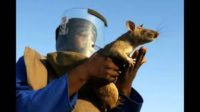10 Apr Trained Rats Detect TB Better Than Microscopy
MedicalResearch.com Interview with:
Georgies Mgode PhD
Sokoine University of Agriculture
Pest Management Centre
African Centre of Excellence for Innovative Rodent Pest Management and Biosensor Technology Development
Morogoro, Tanzania
MedicalResearch.com: What is the background for this study?
Response: The background of this study is the APOPO and Sokoine University of Agriculture together with NIMR and NTLP interest to explore a cheap, reliable and sustainable means of addressing TB problem in high-burden countries with limited access to advanced sensitive tests. This refers to countries where to-date TB diagnosis is mainly by microscopy that is less sensitive leaving majority of patients undetected. We were driven to explore how these rats can contribute to diagnosis of TB in children that is known to be difficult and rats are known to have a better and advanced sense of smell. According to WHO ” an estimated 1 million children became ill with TB and 250 000 children died of TB in 2016 and the actual burden of TB in children is likely higher given the challenge in diagnosing childhood TB.
MedicalResearch.com: What are the main findings?
Response: The main findings include understanding that:
(1) Trained TB detection rats are able to detect TB in sputum samples from children widely known to have poor quality compromising TB diagnosis with conventional tests.
(2) The study show that majority of the children missed by hospitals had sputum containing fewer bacterial load undetectable by direct microscopy. meaning even fewer bacterial produces adequate detectable TB markers.
(3) The TB yield by rats is much higher with younger age in which microscope misses more children.
MedicalResearch.com: What should readers take away from your report?
Response: This detection rats technology combined with the WHO endorsed smear microscopy used to confirm rats results may help address the challenge of TB diagnosis in children in settings where the advanced high-tech diagnostic tests may face challenges in terms of skills needed and infrastructures such as electricity and controlled environment conditions. The rats are widely available and highly adaptive to different climates, easy to train and maintain.
MedicalResearch.com: What recommendations do you have for future research as a result of this work?
Response: Explore improvement of TB diagnosis with broader geographic coverage and other sample sources which may enable TB diagnosis in children without painful sampling.
Disclosures: I acknowledge the support from our research partners including the National Institute for Medical Research (NIMR, Tanzania) and the National Tuberculosis and Leprosy Program (NTLP Tanzania).
Citations:
Mgode, G.F. et al (2018). Pediatric tuberculosis detection using trained African giant pouched rats, Pediatric Research DOI:10.1038/pr.2018.40
[wysija_form id=”3″]
The information on MedicalResearch.com is provided for educational purposes only, and is in no way intended to diagnose, cure, or treat any medical or other condition. Always seek the advice of your physician or other qualified health and ask your doctor any questions you may have regarding a medical condition. In addition to all other limitations and disclaimers in this agreement, service provider and its third party providers disclaim any liability or loss in connection with the content provided on this website.
Last Updated on April 10, 2018 by Marie Benz MD FAAD

